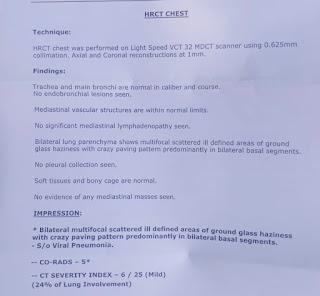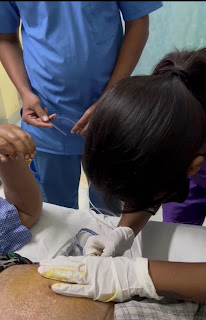A little difference that altered the entire covid recovery game: a report of two patients with focus on imaging findings .
ABSTRACT :
There is high prevalence of viral pneumonia secondary to Covid-19 infection ,characterised by lower respiratory tract symptoms & severe inflammatory response.Studies have suggested that virus has a clinical course with stepwise progression of clinical signs&symptoms and radiologic alterations.This study is aimed to investigate the factors that are responsible for different clinical outcomes.
Case presentation:
This is a two patient centered comparative study .In this case report we discuss two patients who presented with symptoms of Covid-19 infection.CT imaging suggestive of Viral pneumonia secondary to covid .Inspite of many similarities(age,sex,time of presentation,past history,lifestyle and CTSS,CORADS),clinical outcome of the disease was found to be different in both the patients.
Conclusion:
Clinical course of virus may be different in some patients.Special attention should be paid to patients in whom recovery is delayed due to several factors.
Background:
On 31 December 2019, WHO was informed of cases of pneumonia of unknown cause in Wuhan City, China. A novel coronavirus was identified as the cause by Chinese authorities on 7 January 2020 and was temporarily named “2019-nCoV”.
Coronaviruses (CoV) are a large family of viruses that cause illness ranging from the common cold to more severe diseases. A novel coronavirus (nCoV) is a new strain that has not been previously identified in humans. The new virus was subsequently named the “COVID-19 virus”.
The virus can lead to pneumonia, respiratory failure, heart problems, liver problems, septic shock, and death. Many COVID-19 complications may be caused by a condition known as cytokine release syndrome or a cytokine storm.
DISCUSSION:
Following is the comparison of data of two patients ,this study is done to figure out the factors responsible for different clinical outcomes.
|
Patient 1 |
Patient 2 |
|
Age: 45 years |
45 years |
|
Sex : Female |
Female |
|
Duration of fever* : 8-9 days |
6-7 days |
|
Chest pain: present (increased during cough) |
No chest pain |
|
Cough :present |
Cough: present |
|
Not a known case of DM/HTN/TB |
Not a known case of DM/HTN/TB |
|
Family history : not significant (no family members were tested covid positive ) |
Significant (her daughter-in-law was tested positive for covid) |
|
HRCT *: CTSS:6/25, CORAD :5 |
CTSS:6/25. CORAD:5 |
|
Late recovery Date of admission:11/05/2021 *Duration of stay in hospital: 8 days |
Early recovery Date of admission:11/05/2021 Duration of stay in hospital: 3 days |
|
Patient developed DENOVO DM * (GRBS:200mg/dL) |
— |
|
|
|
HRCT of Patient .1
HRCT of patient .2
Comparing CT images of pt.1 and pt.2:
Pt.1. Pt.2
Interpretation: On comparing CT images,it is observed that -there is marked crazy paving peripherally in patient.1 .Whereas in patient .2 it is not appreciated .
Suggesting severe inflammatory reaction in patient.1
Possible factors responsible for different clinical outcomes:
(i) Virus induced DM:
Coronavirus enters hosts cells through Angiotensin II Converting Enzyme receptor (ACE2).ACE2 receptor are also found in the pancreas, both on exocrine cells and in the endocrine cells, that constitute pancreatic islets. Interestingly, its expression is also relevant in the endothelial cells of the microvasculature supplying beta-cells that produce insulin.
- As it has been postulated, upon the 2003-SARS pandemic, coronavirus spike protein enters the cells using the ACE2 receptor, initiating an inflammatory response that leads to apoptosis. Previous studies attempting to understand the pathophysiology of the SARS-CoV-2 infection over different organs and systems, have suggested that, following viral entrance and cell infection, ACE2 receptor is downregulated in lung tissue, which subsequently may trigger an inflammatory response.
- New onset DM could be due to cytokine storm - caused by the severe inflammatory response taking place in the lungs also targets the pancreas possibly causing diabetes .
*New onset DM in patient may be responsible for delayed recovery as the virus may thrive in an environment of elevated blood glucose*.
(ii) Duration of fever (prolonged fever):
Studies suggest that -Patients with prolonged fever(beyond 7days) are more likely to develop hypoxia and have a more pronounced inflammatory response and they are at risk of adverse outcomes from covid-19.
It is also observed that ,there are higher plasma levels of IL-1RA in patients with prolonged fever compared with control patients. Despite being an anti-inflammatory cytokine that acts as a modulator for the IL-1 pathway , IL-1RA has been found to be also associated with increased viral load, lung injury, and severe clinical outcomes . IL-1RA is naturally secreted by human hosts to limit the activity of IL-1 during hyperinflammation . The elevation of circulating IL-1RA may reflect overactive IL-1 activation, which has been reported to associated with severe outcomes in COVID-19 .
•Considering these two criteria i.e, new onset diabetes and prolonged fever (before admission )most probably accounts for severe inflammatory response and inturn Crazy paving on CT imaging in patient.1 ,suggesting delayed recovery .
•Whereas in patient.2 prolonged fever and new onset diabetes were absent ,and many other factors would have favoured her early recovery .
Conclusion :
To conclude ,there are many factors that are responsible for bad prognosis in covid -19 infection ,some of them are prolonged fever and new onset diabetes etc.,There is a need to draw special attention towards these problems to reduce the rates of bad prognosis and mortality.
People who have delayed recovery are of the opinion that the treatment is not appropriate and blame the treatment process, but there are several other factors that are responsible for clinical outcome of a disease .We need to pay special attention in terms of progression of disease and factors effecting the disease process .
Human ethics:
Patient’s deidentified health data is shared after taking signed informed consent from guardian.





Comments
Post a Comment